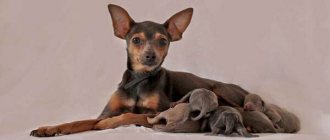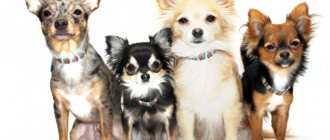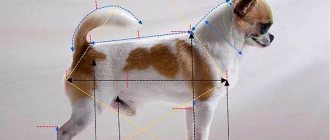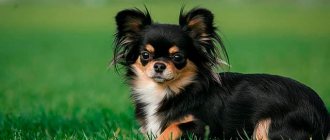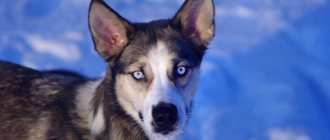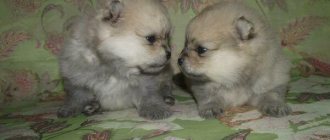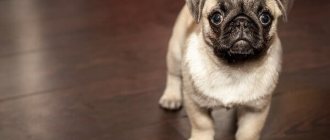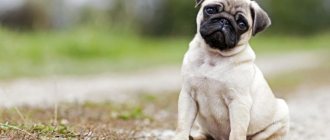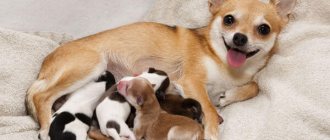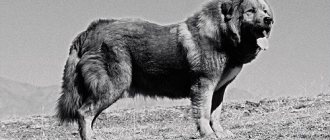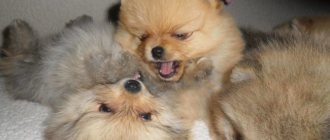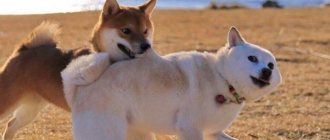Chihuahua puppies are suitable for those who dream of an indoor decorative dog with the disposition of a child. Both at a small age and growing up, these animals remain attached to their owner, like babies. Puppies are in great need of care, attention and control from the owner, especially if there are children or other animals in the house.
What do newborn and older Chihuahua puppies look like?
When born, newborn Chihuahuas are absolutely helpless - they cannot take their first breath until the mother licks them, freeing the airways from mucus. The weight of the babies is very small, only 70-150 g, each of them easily fits in the palm of your hand. Due to their small body weight, Chihuahuas are not able to regulate their temperature, so it is important that they remain close to their mother during this period. The babies' eyes and ears are tightly closed.
There are four stages in the development of sneezes:
- intrauterine – the phase from conception to birth, when all organs and systems are laid and formed;
- suckling – from the moment of birth to one and a half months, until the transition from breast milk to regular nutrition;
- from one and a half months to six months – the period of teeth change and active development;
- from six months to a year is the phase of completion of weight gain and formation of the dog’s character, cessation of growth.
One to two weeks after birth, Chihuahua puppies' temperature reaches 37.8 ⁰C, breathing becomes easy, and the pulse remains rapid. Newborn babies first lose 5-15 g of weight, after which by the end of the second week of life they double their weight. The most active development of sneezes is observed up to three months. If babies stop growing, you need to contact a veterinarian.
Breed characteristics
The Chihuahua breed is active and agile. They have high intelligence, respect their owner and are always devoted to him. They love a lot of attention and are also inquisitive and playful. Although the dog of this breed is small, it is quite brave and strong. During a walk, the pet loves to play with other four-legged friends, so the owner must control it.
They don’t immediately approach strangers; they first take a closer look. Experienced dog breeders claim that the Chihuahua breed is endowed with the character of a terrier. She is quite daring and vigilant. Gets along well with his brothers. If there are children at home, it is better not to buy a pet, as it will protect itself and thereby be able to bite the child. They show their love and affection to their owner and are constantly nearby.
When do puppies' eyes open?
Newborn Chihuahuas are blind. They begin to see only when their eyelids are fully formed. Usually the development process takes one and a half to two weeks. The opening of the eyelids occurs slowly, starting from the inner corner of the eye and gradually moving to the outer corner. First, a thin slit appears, and then one eye opens completely, then the other. When puppies begin to see, they see the world around them blurred, distinguishing only light and darkness. Gradually they begin to see better, and after a week the vision becomes normal. Do not be alarmed by a cloudy iris or a veil on the eyeball. As soon as Chihuahuas are able to focus their gaze on surrounding objects, the veil disappears, and the color of the eyes changes as the puppies develop (by three months).
The period of 12-14 days for the babies’ eyes to open is approximate. The development process does not always go smoothly, but you cannot interfere with it. It is worth protecting newborns from bright light, and if purulent crusts appear on the eyelids, wipe them with an antiseptic. If there is severe suppuration and swelling, contact a veterinarian.
Early eye opening (up to 10 days) occurs due to individual characteristics or a long gestation period. Late sighting (after two weeks) is associated with developmental delay or illness.
Latest Notes
Dogs of the long-haired Chihuahua breed are very sociable and attached to their owners. A sweet, playful and playful little girl who makes many people want to take a photo with your Chihuahua. They do not cause any difficulties in maintenance, caring for them is quite simple.
These four-legged animals feel great in a small city apartment, although they are also very curious and love to walk. When left alone for a long time, they begin to feel sad. This dog is ideal for people who spend a lot of time at home - pensioners, housewives, people with disabilities.
Her devotion borders on jealousy. The Chihuahua will treat all strangers with distrust and will try to never let the owner out of his sight. She has one clear purpose - to be a person’s friend and companion. However, in return, your pet will require no less dedication and love from you.
Development of a Chihuahua puppy by days and months
Despite the fact that newborn Chihuahuas are born very small, they quickly develop and gain weight. If the litter is multiple, the process is slower; if there are few offspring, it is faster. In most cases, one-month-old Chihuahua puppies triple their weight. At three months, development slows down, and at six months it practically stops. The height and weight of dogs may vary, but approximate indicators allow us to classify them into a specific category:
- standard – from 1.8 kg to 3 kg;
- mini – from 1.5 kg to 1.8 kg;
- supermini - from 0.5 kg to 1.5 kg.
| Chihuahua age | Weight (g) | Height (cm) | Behavior, stages of development |
| Newborn | 70-150 | 3-5 | The puppy is blind, deaf, has no thermoregulation, can squeak, suck and crawl clumsily. |
| At 2 weeks | 110-270 | 4-10 | The umbilical cord dries up, sharp claws grow that need to be trimmed, and the dog’s eyes open. |
| At 3 weeks | 145-385 | 5-12 | The puppy is trying to stand up to its full height, its gait is shaky and uncertain. On day 21, the pet is dewormed. |
| At 1 month | 210-650 | 6-13 | The sneeze's weight triples and it gains hearing. Anti-helminth medications are given again. In the fifth week, complementary foods begin to be introduced. |
| At 2 months | 315-1060 | 8-16 | A two-month-old Chihuahua puppy is teething and his testes are dropping. Babies need to be held in your hands more often and communicate with them. At the eighth week, the first vaccination is given if the weight has reached 600 g or more. |
| At 3 months | 435-1420 | 9-18 | Revaccination is carried out. The dogs become independent and can be given to a new owner. |
| At 4 months | 565-1810 | 10-20 | Chihuahuas continue to gain weight, socialize, and begin to obey the hierarchy established in the family. |
| At 5 months | 670-2140 | 11-20 | The dog expands its living space, remembers it, and reinforces the rules of communication and behavior. |
| At 6 months | 750-2410 | 11-22 | The dog is entering adolescence and requires a “steady” hand. |
| At 7 months | 860-2670 | 11,5-22,5 | The Chihuahua becomes disobedient and rude; it needs training and education. |
| At 8 months | 970-2920 | 12-23 | Girls have their first heat and molt, boys mark their territory. |
| At 10 months | 1020-3010 | 12-23 | The Chihuahua gains maximum weight and height. |
| At 12 months | 1030-3010 | 12-23 | Dogs become adults, although physical and psychological development continues. |
Nutrition for an adult dog
A one-year-old representative of this breed should eat twice a day - morning and evening, with a small snack allowed during the day.
After 11 years of life, the pet should be fed once a day.
How many years do Chihuahuas live, read here.
The serving size is calculated based on the dog’s weight - for each kg of weight there should be 50-80 grams. food, i.e. with a weight of 2 kg, a Chihuahua should eat 100-160 grams per day. At the same time, proteins should make up the majority of the daily diet.
Sample menu for the day:
| Times of Day | Menu |
| Morning | Boiled and cut into small pieces beef or sea fish and rice or buckwheat porridge (3:1), grated raw vegetables, seasoned with 1 tsp. olive or vegetable oil |
| Day | A light snack in the form of fruit, kefir or low-fat cottage cheese is possible |
| Evening | Boiled meat and stewed vegetables |
Photos of Chihuahua puppies
How much food should I give?
If you feed dry or canned food, then the manufacturer conscientiously indicates the daily dosage on the packaging. Proportions are indicated according to the age of the dog, so follow the table provided by the manufacturer.
If you feed your Chihuahua natural food prepared at home, then in determining the proportion of the amount of food, its nutritional value, in other words, its calorie content, is of fundamental importance.
A puppy's growing and active body expends more calories and therefore consumes more food than an adult. As you get older, your appetite decreases. It is also important to understand that the amount of calories in dry food and natural food varies greatly. Let’s say that if a table glass (200 grams) of natural food contains 100 kcal, then the same amount of dry food contains about 200 kcal. The figures are for informational purposes only; caloric content is calculated based on the actual ingredients in the food.
What factors influence the growth and development of puppies?
Several factors influence physical and psychological development and the rate at which a dog gains weight:
- Hereditary predisposition - when purchasing a puppy, you need to carefully study its pedigree. Pathology or developmental retardation may appear even after several generations. Genetics dictates what size an adult Chihuahua will be, how quickly it grows, when its first heat occurs, when its teeth erupt or change.
- Regime and conditions of detention - the development of dogs is affected by lighting, temperature and humidity in the room, length of day and night, climate, weather.
- Litter size – the more brothers and sisters a Chihuahua has, the smaller they are at birth. Further, puppies may lag behind in development if they do not have enough breast milk or develop normally when they have enough nutrition and physical activity.
- Feeding and care - a correct, nutritious diet, a cozy, comfortable environment, combined with reasonable physical activity - have a positive effect on the development of the Chihuahua.
Useful tips
You need to care for your Chihuahua properly so that the dog is comfortable. Always follow these guidelines when feeding:
Never feed your dog food that is too hot or cold. Food should be at room temperature.
Never feed your pet from your table. Accustom your Chihuahua to a feeding schedule: it should eat in its place at the appropriate time. The exception is low-fat cheese, vegetables and fruits, which can be given as a reward.
During the hot season, it is best to feed the dog once a day. But your pet should always have access to water. It should not be from the tap or boiled. It is best to use a filter or purchase clean bottled water. You need to change the water in the bowl three to four times a day.
The daily amount of food should be evenly divided into small portions throughout the day. Watch how your Chihuahua eats. If there is food left after feeding, it means the dog has plenty of food. If the pet continues to lick the bowl, then the amount of food needs to be increased slightly.
Don’t overdo it – overfeeding your super mini dog is strictly prohibited. Otherwise, problems with your pet’s health cannot be avoided. For example, obesity and dysfunction in the dog’s musculoskeletal system are possible.
Natural products must be of high quality. If food begins to disappear, it must be thrown away immediately so that the pet does not get poisoned. Always wash fruits and vegetables well. Pay special attention to fermented milk products: cottage cheese, homemade cheese, fermented baked milk should always be fresh. Otherwise, intestinal function may be disrupted.
You should not prepare food from natural products several days in advance. If you do make preparations, always store them in the refrigerator.
If your dog has diarrhea, stop feeding it for a day. At the same time, the dog must have access to water. If after two days the diarrhea has not stopped and the Chihuahua has lost its appetite, you should immediately consult a doctor.
Don't use candy or cookies as rewards. Low-fat cheese, fruit or pieces of raw carrots are perfect for this purpose.
What do you feed your dog?
How old do Chihuahuas grow?
The main physical development of a Chihuahua lasts up to 6-7 months. In the future, the dog’s weight may change due to an unbalanced diet, illness and lack of physical activity.
Up to one and a half months, puppies grow at the withers. At the age of two months, by their appearance it is already possible to determine the exterior of an adult animal. After six months, flat bones increase and the Chihuahua gains a little weight, development slows down significantly, but does not stop. By eight months, the dogs are considered mature, the females begin their first heat, and the males “mark” their territory. If you breed a bitch, she stops growing. Dog handlers advise waiting until the third heat so that the Chihuahua is fully formed.
The development of each puppy is individual, so you should not rely entirely on the breed standards table. Some individuals grow rapidly up to 4-5 months, while in others the process activates later. As adults, male Chihuahuas have a square shape, while girls have smaller, elongated bodies and are shorter in stature.
Feeding during pregnancy
To get healthy offspring, it is necessary to provide the bitch with proper care and proper feeding during pregnancy.
During the first month after mating , if the dog is on a natural diet, changes should not be made to it . If your pet eats commercial food, you need to add raw meat and egg yolks to it.
IMPORTANT!
After 4 weeks of pregnancy, you should increase your daily food intake by adding more protein foods and vitamins A, B1, D, E.
You should also give your Chihuahua fish oil, folic acid, nutritional yeast and bone meal.
Starting from the 5th week, the bitch should eat 3-4 times a day.
After 6 weeks, the Chihuahua’s body is overloaded and needs vitamins and nutrients.:
- vitamin C – does not accumulate and is not produced by the body, a deficiency leads to anemia;
- calcium, potassium, phosphorus - the optimal ratio is found in whole milk;
- proteins - found in raw or boiled yolks, lean meat and fish;
- carbohydrates – millet and eggs.
To avoid eclampsia, which is common among representatives of this breed, you should stop giving fish and meat a week before giving birth.
Deviations from the norm in development
Most deviations in the development of Chihuahua puppies are associated with improper care and maintenance and genetic characteristics of the representatives of the breed. Underfeeding, as well as overfeeding pets, negatively affects their physical condition. Deviations from the standard are considered serious deficiencies. They could be:
- narrow, too wide or flat skull;
- weak stop;
- small or bulging eyes;
- long muzzle;
- drooping ears;
- barrel-shaped or too small chest;
- short neck;
- indirect line of the back;
- elongated body;
- short legs and their narrow set;
- stubby or curled tail;
- jaw displacement, extra teeth.
If there are significant deviations from the standard, you should visit a veterinary clinic, find out the reasons and proceed to treatment, if possible. Most often, developmental disorders occur due to congenital pathologies, digestive disorders, infection with worms, improper care and an unbalanced feeding diet. It happens that babies lag behind in development because they are offended by stronger puppies, pushing them away from their mother’s breast.
Disqualifying defects include:
- too light build or long body;
- cryptorchidism in males;
- weight exceeding 3 kg;
- bald spots on the body;
- docked tail and ears.
Advantages and disadvantages of industrial feeds
A diet based on ready-made industrial feed also has its pros and cons.
The advantages of such feeding include:
- ease of use;
- saving time on cooking;
- ease of storage;
- indication on the packaging of the recommended daily intake of feed;
- the ability to take food with you on trips;
- balanced composition, including all the necessary elements;
- a special coating of dry food granules that helps clean teeth from plaque and stones.
The modern market offers lines of food that take into account the individual characteristics of the dog - age, health status, etc.
Disadvantages of this diet:
- Low quality feed may contain dangerous dyes, preservatives, flavor enhancers and flavorings;
- meat in cheap food is represented by residues from the processing of animal corpses, which the Chihuahua’s body is not able to process.
The content of salts and metals affects the general condition of the pet and has a negative impact on kidney function.
Industrial food is represented not only by dry, but also by wet food.
The latter are characterized by a high liquid content, which has a positive effect on the dog’s gastrointestinal tract, but makes the food less nutritious and significantly reduces its shelf life.
Depending on the composition, industrial feeds come in several classes:
- economy - contains low quality ingredients, possibly containing soy, dyes, flavor enhancers, legumes;
- premium - meat and vegetables were used in the production of such food, but there is no guarantee of the presence of vitamins and minerals in the composition;
- super-premium - made from high-quality products, containing a vitamin and mineral complex.
Almost every manufacturer produces a separate line of hypoallergenic and holistic foods.
How to choose a healthy puppy?
To avoid problems with the health and development of your Chihuahua in the future, you should buy a puppy only from official breeders in nurseries, where they can provide all the documents and pedigree. When choosing, you need to follow the recommendations:
- Inspect the entire litter.
- Do not give in to emotions and do not choose an animal only by eye color, color and size.
- Examine your pet for compliance with the standard twice (with an interval of 2-3 weeks).
- Take the puppy to the veterinarian.
- Pay attention to the conditions of detention (cleanliness of litter, air).
A puppy is healthy if it meets a number of criteria:
- the coat is clean, shiny, there are no fleas or ticks;
- active behavior;
- no discharge from the eyes, nose and ears;
- there is no swelling on the paws, the Chihuahua does not limp;
- no bad breath or dental problems;
- digestion is normal, stool is regular;
- the head has the correct shape;
- Chihuahua reacts to light and sound;
- The baby's movements are coordinated, he has no neurological problems.
Prices
The cost of a puppy depends on which class it belongs to. In total, there are three classes for Chihuahua dogs:
- The show is great. This includes mini and super-mini Chihuahuas. These are puppies that weigh no more than 800 grams. They are prepared for exhibitions, they are able to receive awards and titles. These are the most expensive and valuable animals; they can cost up to 200 thousand rubles. The lower threshold is 50 thousand rubles. The disadvantage of this category is the poor health of dogs, which is due to their low weight. But they are also considered the most popular among breeders and buyers.
- Brid is great. These are animals weighing more than 1.8 kilograms. They have more disadvantages than their show-class counterparts, but they are also suitable for exhibitions, have good reproductive indicators and heredity. Females are actively used for breeding, which is why girls are more expensive than boys (males of this class are almost never taken for breeding). Such puppies will cost from 40 thousand rubles and more.
- Pet is great. The so-called pets. These are the cheapest puppies, but the most unpopular. They are considered defective among breeders: they are not taken for breeding and are not kept for exhibitions, but the character of the dogs remains unchanged, and if the owner has no ambitions for exhibition prizes and future litter, then such puppies will become an excellent family member. Their price varies from 10 to 20 thousand rubles.
Dog handlers recommend not buying Chihuahuas secondhand, at a pet market, or from unverified breeders - the dogs may turn out to be sick, unvaccinated, may develop poorly and die quite soon. What makes up the price of puppies and why are they so expensive? The fact is that raising a purebred dog is painstaking work. The cost of the baby consists of the price of mating, the cost of feeding the puppy and its mother, and vaccinations. Issuing documents and pedigree is also a separate expense item. You should not lose sight of the fact that puppies of this breed remain the most sought after and popular among decorative breeds, and demand affects pricing.
Chihuahua breed standards require certain proportions; if the body is disproportionate, the animal is removed from the exhibition.
Content
For puppies of this breed, it is better to immediately buy a small dog house - they are more willing to sleep there than on an open mattress. However, if you bought a mattress, it will also come in handy. In the summer, it can be hot to sleep in the house and the Chihuahua will happily move to the mattress. In addition, the “household” needs a tray - the dog needs to be accustomed to it for cases when planned walks are cancelled. Your pet should have several bowls - made of metal or ceramic.
Chihuahua needs toys - buy several of them and change them periodically. For walks, a collar and harness, as well as a leash in the form of a tape measure, will be useful. For a small dog, it is advisable to have a special carrier, because you will often have to take it on a visit or travel with it. To care for your Chihuahua, purchase a special comb (or brush), a nail clipper, dog paste and a toothbrush, and dog shampoo.
Walks in the open air
You need to remember: the characteristics of the breed make these dogs curious and brave, so you only need to walk with a Chihuahua on a leash in order to protect them in time from a fight with a dog or cat and other problems. For a Chihuahua, a harness is desirable (a double leash for the neck and body), but it can only be used for adult dogs; in a puppy, it can cause crooked paws. Before you take your baby out for a walk for the first time, you need to make sure that he has received all the necessary vaccinations. It is better to take a walk in warm weather, but not in the heat, so that the dog does not get hurt. Do not allow your dog to eat or even pick up anything from the ground - it may become poisoned.
Organization of a sleeping place
To properly maintain a Chihuahua, you need to provide it with a sleeping place. For relaxation, this dog prefers soft, warm beds or houses - these are sold in any pet store. You need to make sure the structure is strong. You need to lay a soft rug in the house.
When talking about how to care for a Chihuahua, we must not forget about the correct location of the sleeping area. It should not be in a draft, near household or heating appliances, or on a hill. Location next to the door is undesirable. In an apartment with a large area, you can put several places to relax at once.
Conditions of detention
First of all, you need to take care of your pet’s safety and limit access to dangerous objects. Ideally, close all the cracks into which the curious little one will certainly try to crawl. You also need to remove objects that are unstable; falling them can be disastrous for a Chihuahua due to the sensitive fontanel.
Be sure to have a sleeping place for the puppy. You can buy special sun loungers or build something yourself. Under no circumstances should you place the crib near heating devices or in a draft, as this may affect the dog’s health.
If there are already any animals in the apartment, you should think about it, since the Chihuahua considers itself a full-fledged owner of the house and completely refuses to recognize anyone else.
The puppy treats cats with particular distrust, as he is very jealous. It is best to get these two pets at the same time; when they are small, they will definitely make friends and get along with each other in the same apartment.
Cats are freedom-loving and independent by nature, so you need to give them the opportunity to feel like one. You can scold the dog in front of her, the main thing is not to overdo it. See how a Chihuahua and a cat get along in the following video from Funny Animals.
Head
The Chihuahua's skull is very large, apple-shaped, the width and height of which are equal. The voluminous forehead has pronounced eyebrows.
Due to the convexity of the forehead, the transition to the muzzle is clearly visible.
The mini dog's muzzle, wide towards the base, tapers towards the nose. A short muzzle with poorly defined cheekbones has rounded, tightly fitting lips, the dry and tense structure of which should completely cover the teeth.
The small nose may be slightly turned up. The standard allows any color of the nose that matches the coat color.
The large, round eyes of the Chihuahua have an expressive, slightly sly look. Widely spaced ocelli suggest the presence of a deep furrow between them. They should not be too convex. The eye color is dark, matching the coat color, although the standard allows for a light color.
If you look at a Chihuahua from the front, then according to the standard, the eyes and nose of a mini dog form an equilateral triangle.
The standard allows for both scissor and level bites. But an undershot or vice versa - an undershot is already considered a defect. The set of teeth may not be complete - they do not attach much importance to this.
The animal's large ears are set high, wider at the base, tapering to a rounded tip. When the dog is calm, they hang at an angle of forty-five degrees, and when excited they take a vertical position and become closer to each other.
The neck is set high and has a slight bend at the top, without dewlap. In males it is more powerful.
Grooming
When mapping out a plan for how to properly care for your Chihuahua, don’t forget about the coat. Chihuahua breeds can have long or short hair. Smooth-haired dogs should be brushed once or twice a week with a massage mitt or a medium-hard wooden comb. Long-haired cats require brushing every other day. You will need a pet comb with rounded ends or a wooden comb. During shedding, it is better to use a special slicker comb.
In hot weather, a dog with long hair can be trimmed, but for this you should contact a specialist, since it is very easy to spoil the appearance of the dog yourself.
